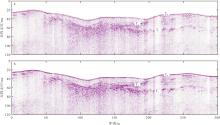Journal of Tropical Oceanography ›› 2025, Vol. 44 ›› Issue (5): 166-178.doi: 10.11978/2024216CSTR: 32234.14.2024216
• Marine Geophysics • Previous Articles Next Articles
A new swell static correction technique based on variational mode decomposition and its application in marine single-channel seismic data processing
WANG Qiang1( ), ZHENG Yu1, LI Jinmei1, ZHAO Minghui2,3,4, ZHANG Jiazheng2,3(
), ZHENG Yu1, LI Jinmei1, ZHAO Minghui2,3,4, ZHANG Jiazheng2,3( )
)
- 1. Institute of Marine Geological Survey, Fujian Xiamen Institute of Geological Engineering, Xiamen 361008, China
2. Laboratory of Ocean and Marginal Sea Geology of Chinese Academy of Sciences, South China Sea Institute of Oceanology, Chinese Academy of Sciences, Guangzhou 510301, China
3. State Key Laboratory of Tropical Oceanography, South China Sea Institute of Oceanology, Chinese Academy of Sciences, Guangzhou 510301, China
4. College of Earth and Planetary Sciences, University of Chinese Academy of Sciences, Beijing 100049, China
-
Received:2024-11-23Revised:2025-01-23Online:2025-09-10Published:2025-10-14 -
Contact:ZHANG Jiazheng -
Supported by:National Natural Science Foundation of China(42106082); Basic and Applied Basic Research Foundation of Guangdong Province(2024A1515030181); Construction Science and Technology Project of Xiamen(XJK2023-1-13); Provincial Geological Exploration Special Foundation of Fujian(GY20210301)
CLC Number:
- P731.22
Cite this article
WANG Qiang, ZHENG Yu, LI Jinmei, ZHAO Minghui, ZHANG Jiazheng. A new swell static correction technique based on variational mode decomposition and its application in marine single-channel seismic data processing[J].Journal of Tropical Oceanography, 2025, 44(5): 166-178.
share this article
Add to citation manager EndNote|Reference Manager|ProCite|BibTeX|RefWorks

Fig. 2
Single-channel seismic data affected by swell noise causing jitter in formation morphology. (a) Single-channel seismic profile affected by the swell effect; (b) amplified view of traces 1-10, where the red solid line represents the two-way travel time curve of the first-arrival seafloor reflection phase (ΔTs), and the green solid line represents the two-way travel time curve of a sub-seafloor reflection phase (ΔTi)"

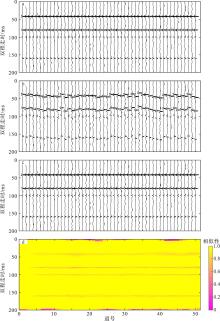
Fig. 3
Swell static correction results for synthetic gather data. (a) Original synthetic seismic section of horizontal layered model; (b) synthetic section with Gaussian white noise and swell effects; (c) results after applying the proposed swell static correction method; (d) local similarity between original synthetic data (a) and swell-corrected results (c), where values closer to 1.0 (yellow) indicate higher similarity before/after correction, while values closer to 0 (pink) indicate lower similarity"

Tab. 1
Center frequencies corresponding to different mode numbers K"
| K | 中心频率/Hz | |||||||
|---|---|---|---|---|---|---|---|---|
| 2 | 0 | 0.0128 | - | - | - | - | - | - |
| 3 | 0 | 0.0119 | 0.0746 | - | - | - | - | - |
| 4 | 0 | 0.0114 | 0.0513 | 0.0906 | - | - | - | - |
| 5 | 0 | 0.0113 | 0.0505 | 0.0855 | 0.1595 | - | - | - |
| 6 | 0 | 0.0113 | 0.0503 | 0.0763 | 0.1380 | 0.1604 | - | - |
| 7 | 0 | 0.0112 | 0.0502 | 0.0751 | 0.1192 | 0.1405 | 0.1604 | - |
| 8 | 0 | 0.0112 | 0.0501 | 0.0749 | 0.1188 | 0.1400 | 0.2503 | 0.1602 |
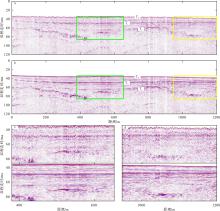
Fig. 4
Swell static correction results for single-channel seismic data with gently undulating seafloor. (a) Original profile; (b) profile after swell static correction; (c) upper/lower panels show amplified views of green boxes in (a) and (b), respectively; (d) upper/lower panels show amplified views of yellow boxes in (a) and (b), respectively"

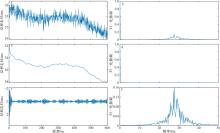
Fig. 5
VMD results and corresponding spectra for first-arrival reflections from gently undulating seafloor. (a) Original first-arrival reflection data; (b) spectrum of (a); (c) IMF1 component after VMD decomposition; (d) spectrum of (c); (e) IMF2 component after VMD decomposition; (f) spectrum of (e)"

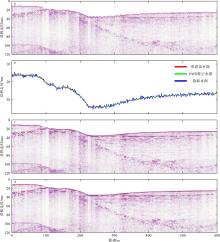
Fig. 7
Comparative analysis between single-beam data correction and proposed method correction results. (a) Original profile; (b) single-beam bathymetry, picked arrivals and VMD swell-corrected bathymetry; (c) profile after VMD-based swell static correction; (d) profile after single-beam bathymetry correction"

| [37] |
周勐佳, 吴自银, 马胜中, 等, 2016. 台湾海峡晚更新世以来的高分辨率地震地层学研究[J]. 海洋学报, 38(9): 76-88.
|
|
|
|
| [38] |
|
| [39] |
|
| [40] |
|
| [41] |
|
| [42] |
doi: 10.1109/tip.2003.819861 pmid: 15376593 |
| [43] |
|
| [44] |
|
| [45] |
doi: 10.1007/s11356-020-08452-6 pmid: 32215801 |
| [1] |
陈梅, 夏真, 刘文涛, 等, 2022. 南海宣德环礁东南海域地质灾害特征[J]. 热带海洋学报, 41(2): 103-111.
doi: 10.11978/2021046 |
|
doi: 10.11978/2021046 |
|
| [2] |
褚宏宪, 史慧杰, 杨源, 等, 2010. 利用涌浪滤波器提高水深测量精度的实践[J]. 海洋测绘, 30(4): 51-53, 62.
|
|
|
|
| [3] |
褚宏宪, 杨源, 张晓波, 等, 2012. 高分辨率单道地震调查数据采集技术方法[J]. 海洋地质前沿, 28(12): 70-74.
|
|
|
|
| [4] |
丁承君, 张良, 冯玉伯, 等, 2020. VMD和t-SNE相结合的滚动轴承故障诊断[J]. 机械科学与技术, 39(5): 758-764.
|
|
|
|
| [5] |
丁维凤, 冯霞, 傅晓明, 等, 2012. 海上单道地震与浅地层剖面数据海浪改正处理研究[J]. 海洋学报, 34(4): 91-98.
|
|
|
|
| [6] |
付小波, 余嘉顺, 侯小平, 2019. 单道地震浪静校正技术研究[C]// 中国石油学会2019年物探技术研讨会论文集, 成都: 561-564 (in Chinese).
|
| [7] |
郝高建, 年永吉, 罗进华, 等, 2019. 一种中浅地层剖面高精度成像的处理方法[J]. 地球物理学进展, 34(6): 2437-2443.
|
|
|
|
| [8] |
侯一筠, 段永亮, 陈更新, 等, 2009. 浅水非线性随机海浪的波高分布[J]. 中国科学(D辑: 地球科学), 39(12): 1795-1800.
|
|
|
|
| [9] |
胡梦涛, 李太春, 廖荣发, 等, 2019. 参量阵浅剖探测技术在海底管线探测中的应用[J]. 海洋测绘, 39(5): 30-34.
|
|
|
|
| [10] |
胡毅, 丁见祥, 房旭东, 等, 2016. 水下考古区域调查与海洋地球物理方法[J]. 科学, 68(6): 32-35, 3.
|
|
|
|
| [11] |
|
|
|
|
| [12] |
李海东, 胡毅, 许江, 等, 2019. 浅地层剖面系统在福建沿海海底沉船调查中的应用[J]. 海洋技术学报, 38(1): 79-84.
|
|
|
|
| [13] |
李海东, 许江, 郑江龙, 等, 2016. 广西近海灾害地质因素及声学反射特征[J]. 应用海洋学学报, 35(2): 275-283.
|
|
|
|
| [14] |
李丽青, 徐华宁, 舒虎, 2007. 涌浪静校正技术在海洋单道地震资料处理中的应用[J]. 物探与化探, 31(4): 339-343.
|
|
|
|
| [15] |
李守军, 初凤友, 方银霞, 等, 2010. 南海北部陆坡神狐海域浅地层与单道地震剖面联合解释: 水合物区沉积地层特征[J]. 热带海洋学报, 29(4): 56-62.
|
|
|
|
| [16] |
李守军, 陶春辉, 初凤友, 等, 2007. 浅地层剖面在富钴结壳调查研究中的应用[J]. 海洋技术, 26(1): 54-57.
|
|
|
|
| [17] |
李勇航, 贾磊, 倪玉根, 等, 2021. 中国台湾浅滩海砂砂体的地球物理特征及有利赋存标志[J]. 热带海洋学报, 40(5): 101-110.
doi: 10.11978/2020108 |
|
|
|
| [18] |
刘阿成, 张杰, 唐建忠, 2022. 闽江口外海域MIS 5和MIS 3的地震地层学特征和古环境[J]. 应用海洋学学报, 41(1): 109-119.
|
|
|
|
| [19] |
刘阿成, 唐建忠, 吴巍, 等, 2019. 闽江口外海域晚第四纪地震层序和古河道演变[J]. 海洋与湖沼, 50(1): 61-73.
|
|
|
|
| [20] |
刘阿成, 张杰, 唐建忠, 2020. 闽江口外海域全新统地震地层学特征和沉积作用[J]. 海洋学报, 42(11): 49-61.
|
|
|
|
| [21] |
刘玉萍, 李丽青, 赵斌, 等, 2019. 海洋低信噪比单道地震资料特点及处理策略[J]. 海洋地质前沿, 35(7): 25-33.
|
|
|
|
| [22] |
刘忠波, 周林, 杜沂霖, 2020. 浅水非线性长波演化的高精度模拟[J]. 海洋环境科学, 39(6): 887-894.
|
|
|
|
| [23] |
陆基孟, 2006. 地震勘探原理[M]. 东营: 中国石油大学出版社.
|
|
|
|
| [24] |
骆迪, 蔡峰, 吴志强, 等, 2019. 海洋短排列高分辨率多道地震高精度成像关键技术[J]. 地球物理学报, 62(2): 730-742.
doi: 10.6038/cjg2019M0178 |
|
|
|
| [25] |
罗进华, 潘国富, 丁维凤, 2009. 消除涌浪对海底声学地层剖面影响的处理技术研究[J]. 声学技术, 28(1): 21-24.
|
|
|
|
| [26] |
马永, 李家彪, 吴自银, 等, 2016. 综合物探技术在海洋考古中的应用: 以川岛水下考古为例[J]. 海洋学研究, 34(2): 43-52.
doi: 10.3969/j.issn.1001-909X.2016.02.006 |
|
|
|
| [27] |
聂荣, 许辉群, 赵桠松, 2024. 联合VMD和Shearlet变换的去噪方法研究[J]. 工程地球物理学报, 21(1): 176-186.
|
|
|
|
| [28] |
蒲进菁, 李太春, 唐梓力, 等, 2022. 无人船在近浅海水下考古领域的工程实践[J]. 海洋测绘, 42(3): 52-55.
|
|
|
|
| [29] |
唐贵基, 王晓龙, 2015. 参数优化变分模态分解方法在滚动轴承早期故障诊断中的应用[J]. 西安交通大学学报, 49(5): 73-81.
|
|
|
|
| [30] |
王方旗, 吕京福, 申宏, 等, 2013. 浅地层剖面资料解释中的陷阱问题分析[J]. 物探与化探, 37(6): 1061-1066.
|
|
|
|
| [31] |
魏志强, 张志强, 蒋俊杰, 2009. 浅地层剖面仪在大亚湾海底管道检测中的应用[J]. 海洋测绘, 29(6): 71-73.
|
|
|
|
| [32] |
吴水根, 周建平, 顾春华, 等, 2007. 全海洋浅地层剖面仪及其应用[J]. 海洋学研究, 25(2): 91-96.
|
|
|
|
| [33] |
邢子浩, 义家吉, 杨德鹏, 等, 2023. 基于同步单波束测深数据的单道地震涌浪静校正方法[J]. 海洋地质与第四纪地质, 43(4): 181-188.
|
|
|
|
| [34] |
杨慧良, 陆凯, 褚宏宪, 2019. 海洋地质地球物理调查技术方法发展趋势探讨[J]. 海洋地质前沿, 35(9): 1-5.
|
|
|
|
| [35] |
张彬彬, 吴永亭, 张海泉, 等, 2021. 浅地层剖面仪剩余涌浪影响分析及消除方法研究[J]. 地球物理学进展, 36(2): 834-839.
|
|
|
|
| [36] |
钟广见, 文鹏飞, 罗文造, 等, 2007. 电缆沉放深度对地震资料品质的影响[J]. 海洋地质与第四纪地质, 27(6): 131-134.
|
|
|
| [1] | LI Yonghang, JIA Lei, NI Yugen, HE Jian, MU Zelin, WEN Mingming, SHAN Chenchen. Geophysical characteristics and favorable occurrence signs of marine sand-gravel body in Taiwan banks* [J]. Journal of Tropical Oceanography, 2021, 40(5): 101-110. |
| [2] | LI Shou-jun,CHU Feng-you,FANG Yin-xia,WU Zi-yin,NI Yu-gen. Associated interpretation of sub-bottom and single-channel seismic profiles from slope of Shenhu Area in the northern South China Sea—characteristics of gas hydrate sediment [J]. Journal of Tropical Oceanography, 2010, 29(4): 56-62. |
|
||




